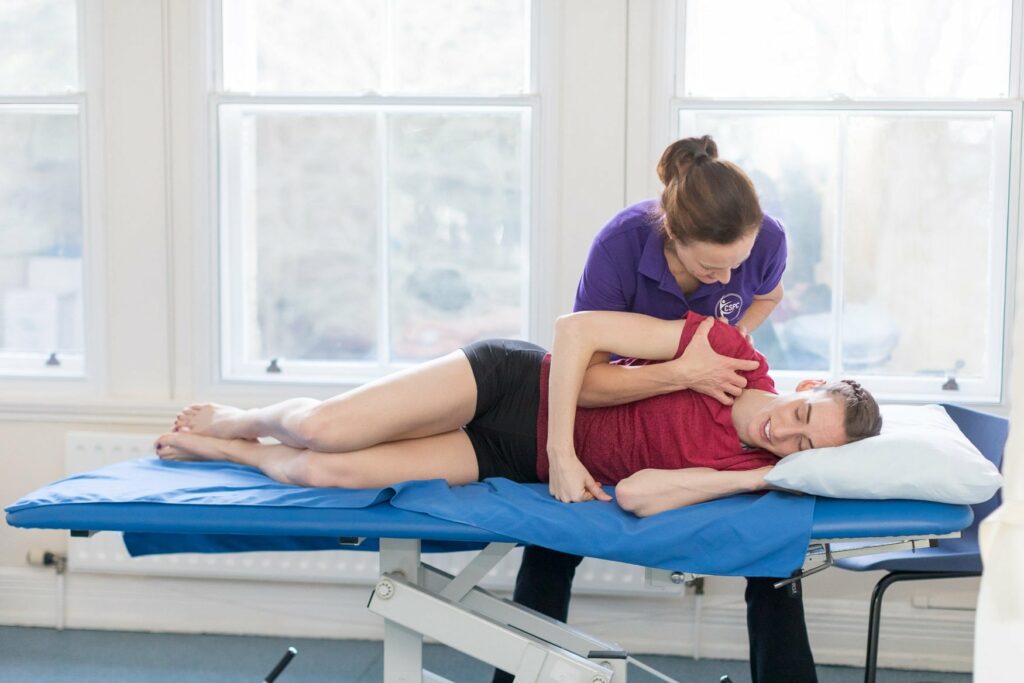PELVIC GIRDLE PAIN (PGP)
At CSPC physiotherapy clinic, a number of our physiotherapists are experienced in treating pregnancy-related pelvic girdle pain (PRPGP or pregnancy-related PGP) and are registered as recommended practitioners by the Pelvic Partnership
At CSPC, a number of the physios are experienced in treating pregnancy-related pelvic girdle pain (PRPGP or pregnancy-related PGP). We have experience of treating women during all stages of their pregnancy, including those who suddenly run into difficulty during a pregnancy. We have worked with women wanting to get in shape for their pregnancy, and we have also worked with women who have had a previous pregnancy, had problems ever since, and come to see us a number of years later, wanting to have another baby, but hopefully without the issues they had the last time.
Pregnancy-related PGP is a term to describe pain in and around the pelvic girdle, which comes on during pregnancy, due to the release of the hormone relaxin and the changes that occur within a woman’s body during pregnancy. This pain can be coming from the pubic symphysis at the front of the pelvis, from the sacro-iliac (SI) joints at the back, the lower back and the hips. Sometimes it is simply from the combination of all of these things. Pregnancy-related PGP used to be called symphysis pubis dysfunction (SPD) or osteitis pubis (OP).

Causes of pregnancy-related pelvic girdle pain (PRPGP)
Pelvic pain during pregnancy is partly due to a hormone called relaxin which is released from the beginning of the pregnancy and helps to prepare the ligaments in the pelvis for birth. Relaxin starts to affect the ligaments of the pelvis from six weeks, and reaches it’s peak at twelve weeks. This high level of relaxin continues throughout pregnancy and not only affects the ligaments around the pelvis, but also affects all the other ligaments in the body, causing there to be more joint play in all joints. The pubic symphysis and sacroiliac joints are particularly affected by relaxin. This laxity in the ligaments around the pelvis, hips and feet will alter the lower limb biomechanics which further affects the stability of the pelvis, and this can result in pain.
Pelvic pain is also due to alterations in the position of the pelvis and the size of the bump. The pelvis can tip anteriorly, which will put additional stress on the SI joints and the pubic symphysis. This will mean that the bump is lying slightly more in front of the pelvic rim, rather than on top of it, and will result in increased tightness in the back muscles to support this. Some of the anterior tilt of the pelvis can also be due to tightness in the quadriceps muscles (the muscles down the front of the thighs), which attach onto the front of the pelvis and will tip it further forwards.
Treating pregnancy-related pelvic girdle pain (PRPGP)
As with any injury, it is important to work out why the person is experiencing pain or dysfunction. The physios that work with this condition will do a thorough examination, taking into account the stage of pregnancy, if it is the first or subsequent pregnancy, the size of the bump, symptoms, alignment of the pelvis, ligamentous laxity, and muscle strength and flexibility, particularly in muscles attaching onto the pelvis, and which may be pulling the pelvis out of line. From this, it is possible to advise on stretches or strengthening exercises that may help the person to have as comfortable pregnancy as possible. It is possible to do gentle realignment work on the pelvis, it is just necessary to adapt some of our techniques due to the bump!
Pain stops your muscles working properly, so exercising when you are in a lot of pain can often make you worse, and is unlikely to make you stronger. By correcting the pelvic position, and reducing your pain, it is possible for the muscles to work better to support your pelvis in a more functional way, which should help manage the symptoms.
Pregnancy and osteitis pubis
Pregnancy and the pudendal nerve
Further information
A lot of further information and resources for pregnancy related pelvic girdle pain can be found on the Pelvic Partnership website: Pelvic Partnership or https://pelvicpartnership.org.uk
MEET THE TEAM
Constantly challenging ourselves to be the best
See why patients
love CSPC Physiotherapy



